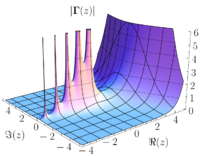
Back معادلة لابلاس Arabic Ecuación de Laplace AST Laplas tənliyi Azerbaijani Ураўненне Лапласа Byelorussian Уравнение на Лаплас Bulgarian Equació de Laplace Catalan Лаплас танлăхĕ CV Hafaliad Laplace Welsh Laplace' ligning Danish Laplace-Gleichung German
| Mathematical analysis → Complex analysis |
| Complex analysis |
|---|
 |
| Complex numbers |
| Complex functions |
| Basic theory |
| Geometric function theory |
| People |
In mathematics and physics, Laplace's equation is a second-order partial differential equation named after Pierre-Simon Laplace, who first studied its properties. This is often written as or where is the Laplace operator,[note 1] is the divergence operator (also symbolized "div"), is the gradient operator (also symbolized "grad"), and is a twice-differentiable real-valued function. The Laplace operator therefore maps a scalar function to another scalar function.
If the right-hand side is specified as a given function, , we have
This is called Poisson's equation, a generalization of Laplace's equation. Laplace's equation and Poisson's equation are the simplest examples of elliptic partial differential equations. Laplace's equation is also a special case of the Helmholtz equation.
The general theory of solutions to Laplace's equation is known as potential theory. The twice continuously differentiable solutions of Laplace's equation are the harmonic functions,[1] which are important in multiple branches of physics, notably electrostatics, gravitation, and fluid dynamics. In the study of heat conduction, the Laplace equation is the steady-state heat equation.[2] In general, Laplace's equation describes situations of equilibrium, or those that do not depend explicitly on time.
Cite error: There are <ref group=note> tags on this page, but the references will not show without a {{reflist|group=note}} template (see the help page).
- ^ Stewart, James. Calculus : Early Transcendentals. 7th ed., Brooks/Cole, Cengage Learning, 2012. Chapter 14: Partial Derivatives. p. 908. ISBN 978-0-538-49790-9.
- ^ Zill, Dennis G, and Michael R Cullen. Differential Equations with Boundary-Value Problems. 8th edition / ed., Brooks/Cole, Cengage Learning, 2013. Chapter 12: Boundary-value Problems in Rectangular Coordinates. p. 462. ISBN 978-1-111-82706-9.







